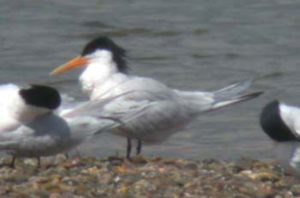Changes to the British List (8 Jan 2018)
8 January 2018
The British Ornithologists’ Union Records Committee (BOURC) has accepted the following to the British List.
Elegant Tern Thalasseus elegans
Third-calendar-year or older, Dawlish Warren NNR, Devon, 18 May 2002 (photographed).

Elegant Tern, Dawlish Warren, Devon, 18 May 2002 © Paul Marshall
Identification of the various species that comprise the orange-billed group of terns has received much attention, with it established recently that birds showing the correct suite of features of Elegant Tern can be safely identified as this species (Journal of Ornithology 158, 351-361). This has allowed the Dawlish Warren record to be accepted as the British first.
Breeds in coastal south-west USA and north-west Mexico, dispersing along the west coast of Latin America.
It should be placed after Cabot’s Tern Thalasseus acuflavidus on the British List.
Other decisions:
Royal Tern Thalasseus maximus
First-calendar-year, Kenfig (Cynffig), Mid Glamorgan (Morgannwg Ganol),
24 November 1979 (sight record, ringing recovery).
A review of British records of Royal Tern was instigated to establish the first acceptable record. This resulted in the rejection of the St Ives, Cornwall record from 2 September 1971, and the retention of the Kenfig record. The review also confirmed that the Kenfig individual belonged to the nominate Nearctic subspecies maximus. This was due to a leg-ring that established it being marked in a North American breeding colony.
There are potential future changes in the taxonomy of Royal Tern, with the two subspecies on either side of the Atlantic likely being split to create two new species (Biological Journal of the Linnean Society 121, 439-445). DNA evidence suggests that West African albididorsalis birds are more closely related to Lesser Crested Tern Thalasseus bengalensis. If this taxonomic revision occurs the Kenfig record will become the first British record of this new monotypic species.
Nominate maximus breeds from coastal southern California to Peru, and from Florida and the West Indies to Argentina; with albididorsalis breeding from Mauritania to Guinea, dispersing south to Namibia.
Thayer’s Gull Larus glaucoides thayeri
New first record: a first-calendar-year/second-calendar-year bird at Stanton Harcourt, Oxford from 4 December 2007 to 8 January 2008, with the same at Erin Tip, Pools Brook CP and Markham Pit Yard, Derby on 16-18 February 2008 (photographed) pre-dates the previously accepted first record of this subspecies, and is therefore accepted as the first British record.
Further details of these decisions will be published as part of the BOURC’s 49th report due to be published in Ibis in October 2018. Upon publication of these decisions, the British List stands at 615 species (Category A = 597; Category B = 8; Category C = 10).
View the British List, sponsored by Leica

